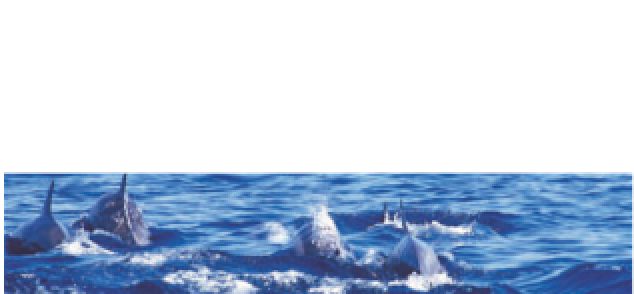Travel Reference
In-Depth Information
Bottle-nosed dolphins
Garajau Marine Reserve Sights
!
Monk Seal
^
Common Dolphin
Europe's most endangered
mammal, the monk seal was
once persecuted by Madeiran
fishermen. The small surviving
colony is now protected, but can
be seen on trips to the Ilhas
Desertas
(see pp52, 88)
.
@
Sperm Whale
No longer as common as
their name suggests. Population
numbers of these endangered
mammals have bounced back,
however, since the creation of
Madeira's ocean marine reserve.
&
Bottle-nosed Dolphin
The bottle-nosed dolphin is
another sea mammal that has
benefited from the creation of
the reserve, which stretches
200,000 km sq (77,200 sq miles)
from eastern Madeira to the
Ilhas Selvagens (“Wild Islands”),
a group of uninhabited rocks
north of the Canary Islands.
*
Gulls
Canićal's fishermen caught
their last sperm whale in 1981.
This is the whale you are most
likely to see on whale-watching
trips
(see p52)
.
£
Humpback Whale
The humpback loves to leap
out of the water and perform
acrobatic somersaults (known as
“breaching”). Madeirans can reg-
ularly spot this graceful whale
offshore during the winter. A
mere 20,000 remain in existence.
$
Pilot Whales
Herring gulls and western
yellow-legged gulls are the
seabirds you are most likely to
see on boat trips or hanging
around fishing ports such as
Canićal or Funchal.
(
Common Terns
Large schools of pilot
whales use Madeira as a migra-
tion route as they pass between
the sub-tropical waters of the
Canary Islands on their way
north to the Arctic, though their
precise route remains a mystery.
%
Killer Whales
Related to gulls, but with a
deeply forked tail and a graceful
flight, Common terns can be
seen from the lookout point at
Garajau, skimming the water and
diving for small fish.
)
Shearwaters
Despite their name, these
big whales (the largest members
of the dolphin family) have never
been known to attack humans -
they are more likely to attack
other whales. Solitary killer
whales can often be spotted
patrolling Madeira's warm waters.
The shearwater is able to
glide just above the waves,
scarcely moving its wings. Once
it was hunted by fishermen, who
regarded it as a delicacy. Madei-
ra has more than six varieties,
including the Great Shearwater.
90

































































































